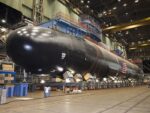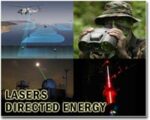The U.S. Coast Guard (USCG) is embarking on a significant modernization initiative with a $350 million investment into robotics and autonomous systems. This funding aims to accelerate the deployment of unmanned surface vessels (USVs), artificial intelligence (AI)-enabled platforms, and advanced sensors to bolster maritime domain awareness (MDA), interdiction capabilities, and operational endurance in contested or remote waters.
Strategic Context: Robotics in the USCG’s Future Force Design
This investment aligns with the USCG’s broader Force Design 2030 vision—a strategic roadmap that emphasizes distributed operations, data-driven decision-making, and platform autonomy. Unlike the Navy or Marine Corps, the Coast Guard operates under both Title 10 (military) and Title 14 (law enforcement) authorities. This dual-role mandate requires flexible platforms capable of executing missions ranging from drug interdiction to search-and-rescue (SAR) to Arctic patrols.
Rear Admiral John Mauger, Assistant Commandant for Capability at the USCG, emphasized that robotics will allow the service to “extend presence without putting people in harm’s way.” The move reflects growing interest across U.S. military branches in leveraging unmanned systems for persistent ISR (intelligence, surveillance & reconnaissance), logistics resupply in denied environments, and deterrence through distributed sensing.
Program Overview: Funding Breakdown and Capability Goals
The $350 million allocation—sourced from Congressional appropriations tied to FY2023–FY2025—is structured across several lines of effort:
- Unmanned Surface Vessels (USVs): Development of long-endurance USVs for persistent patrols in high-risk or remote areas such as the Eastern Pacific drug transit zones or Arctic approaches.
- Autonomous Navigation Systems: Integration of AI-enabled navigation suites capable of obstacle avoidance, route optimization under weather constraints, and cooperative behavior with manned assets.
- C4ISR Integration: Upgrades to command-and-control architecture allowing seamless data fusion between unmanned platforms and shore-based operations centers via SATCOM/Link-16 equivalents.
- Sensors & Payloads: Deployment of EO/IR cameras, AIS spoofing detection modules, radar cross-section reduction technologies for stealthier ISR collection.
The initial tranche of funding will support prototyping efforts by both traditional defense primes and non-traditional vendors under Other Transaction Authority (OTA) agreements. The USCG has indicated preference for modular open-systems architectures (MOSA) that enable rapid payload swaps depending on mission profile—whether counter-narcotics or fisheries enforcement.
Operational Use Cases: From Drug Interdiction to Arctic Surveillance
The Coast Guard faces increasing operational demand across diverse theaters—from transnational criminal networks operating semi-submersibles in the Eastern Pacific to Chinese illegal fishing fleets near American Samoa. Unmanned platforms offer force multiplication without requiring additional crewed cutters or aircraft deployments.
Key mission scenarios include:
- Counter-Narcotics Patrols: Deploying small-to-medium displacement USVs equipped with EO/IR sensors and AIS sniffers along known smuggling routes between Colombia and Central America.
- SAR Augmentation: Using autonomous boats as first responders during hurricane season when manned assets are overstretched or grounded due to weather conditions.
- Arctic Domain Awareness: Operating ice-hardened robotic vessels north of Alaska where communications latency is high but persistent presence is essential due to Russian naval activity or commercial shipping growth along the Northern Sea Route.
This approach mirrors similar efforts by U.S. Southern Command’s “Unmanned Influence” campaign which tested Saildrone Explorer-class vehicles for MDA enhancements off Ecuador’s Galápagos EEZ boundary in coordination with NOAA data streams.
Industry Participation: Key Players and Prototypes
The USCG has issued a series of RFI/RFPs since late 2023 targeting vendors capable of delivering autonomous maritime solutions within two years. Among those participating are established players like Leidos—with its Sea Hunter trimaran concept—and smaller firms such as Spatial Integrated Systems Inc., which specializes in AI-based vessel control algorithms validated under DARPA’s Sea Train program.
A few notable prototype platforms include:
- Saildrone Voyager Class: Wind-powered USV with solar backup; already tested by NOAA for oceanographic monitoring; now adapted for ISR roles via modular payload bay.
- MANTAS T38 by MARTAC: Catamaran-style medium-displacement vessel used by U.S. Navy Task Force 59; capable of speeds over 40 knots; sensor suite includes EO/IR + radar + acoustic detection arrays.
- L3Harris ASView Control Suite: Autonomy package enabling remote operation or full autonomy; compatible with RHIB-class vessels already used by USCG boarding teams.
The Coast Guard is also exploring hybrid teaming concepts where a single cutter serves as mothership/controller node for multiple unmanned assets operating up to hundreds of nautical miles away using mesh networking protocols akin to those developed under Project Overmatch/Navy JADC2 initiatives.
C4ISR Challenges: Bandwidth Limits & Decision Latency
A critical barrier remains robust command-and-control over long distances—particularly given limited SATCOM bandwidth aboard legacy cutters. The service is evaluating low-Earth orbit satellite constellations such as Starlink Maritime or Iridium Certus as potential enablers for real-time telemetry from robotic assets operating beyond line-of-sight (BLOS).
This ties into broader DoD-wide efforts around Joint All-Domain Command & Control (JADC2), where sensor fusion from disparate domains must be processed rapidly at edge nodes using AI/ML inference engines onboard unmanned platforms themselves—rather than relying solely on cloud-based analysis centers ashore.
Training & Human-Machine Teaming Doctrine Development
The shift toward robotic operations also necessitates doctrinal evolution within the Coast Guard Academy curriculum and field units. A new training pipeline is being developed for “Robotic Systems Operators” who will manage swarms or individual platforms while interpreting multi-modal sensor feeds under time pressure during law enforcement actions or SAR events.
Pilot programs underway at Sector San Diego involve pairing junior officers with software engineers from DHS Science & Technology Directorate under a human-machine teaming framework designed around trust calibration thresholds—e.g., when should an operator override autonomy during a boarding intercept?
Tactical Implications Across Homeland Security Missions
This investment signals a shift toward more agile homeland defense postures amid rising gray-zone threats—from cartel drone drops along maritime borders to foreign state actors probing U.S. EEZ boundaries via disguised trawlers equipped with SIGINT gear. Robotic systems offer persistent eyes-on-target capabilities without escalating risk profiles associated with manned escalation ladders.
If successful at scale by FY2026–27 milestones, this program could serve as a model not only within DHS but also among allied coast guards facing similar resource constraints yet expanding threat vectors—from Canada’s Arctic sovereignty patrols to Japan’s East China Sea monitoring missions against PLAN incursions near Senkaku Islands.









